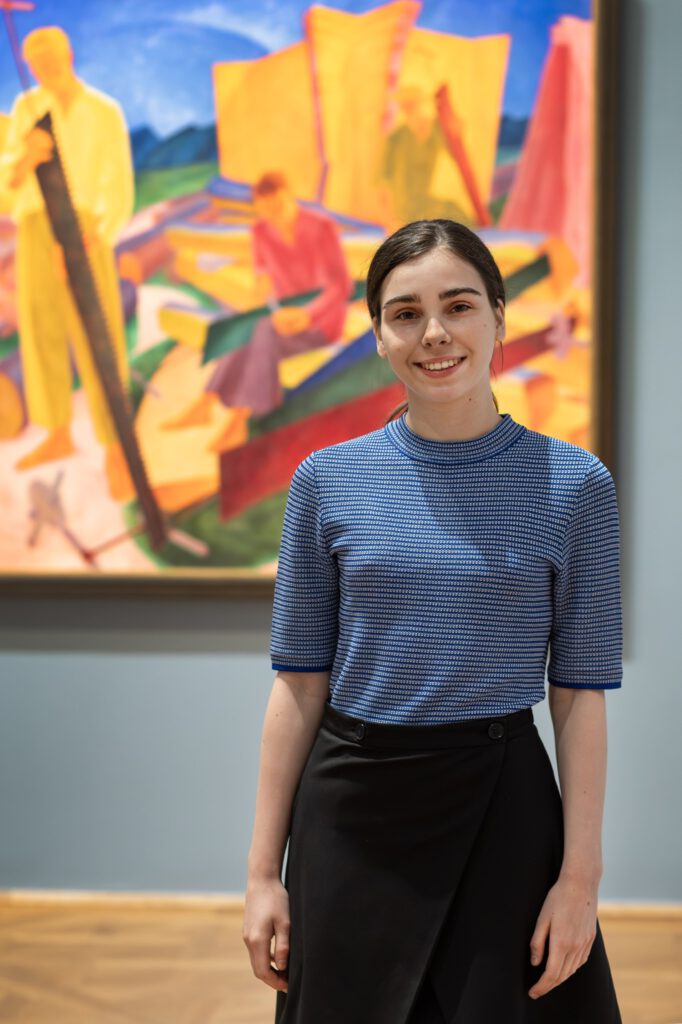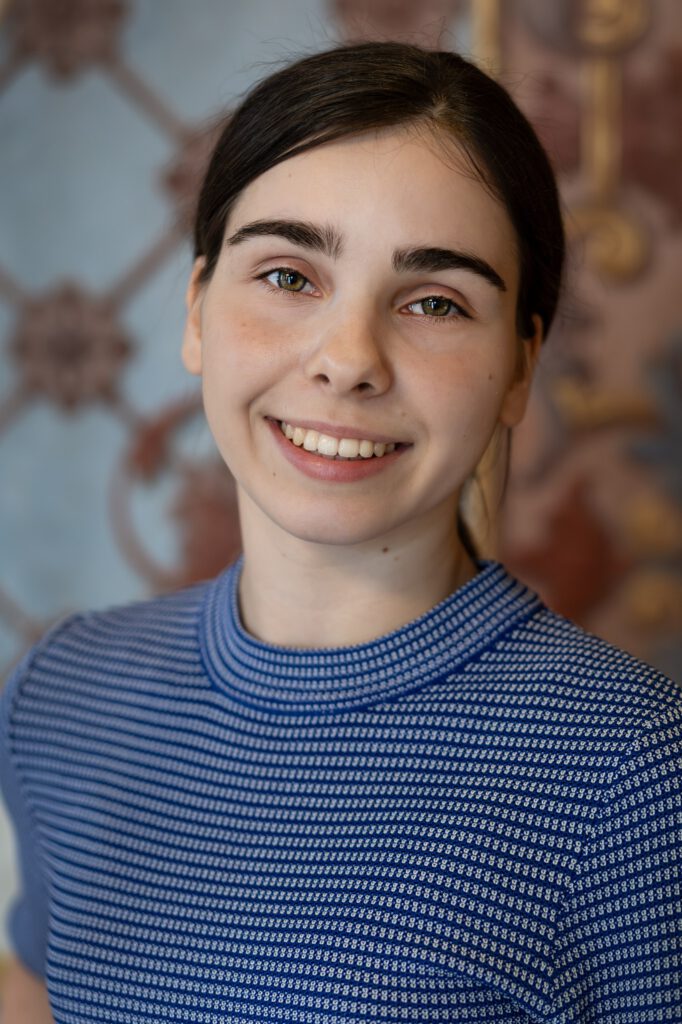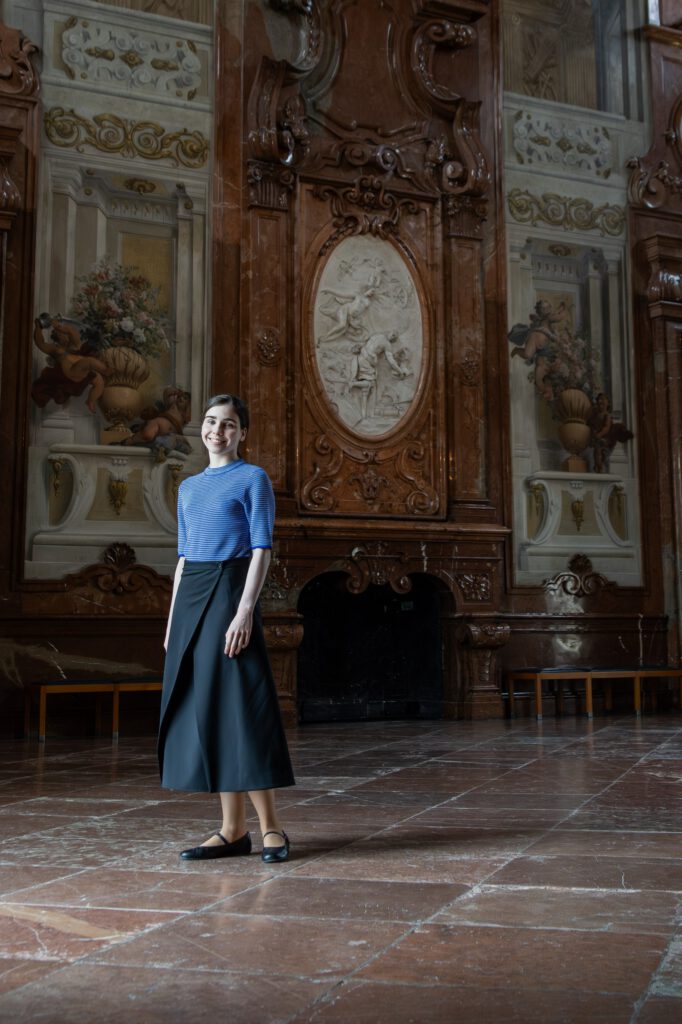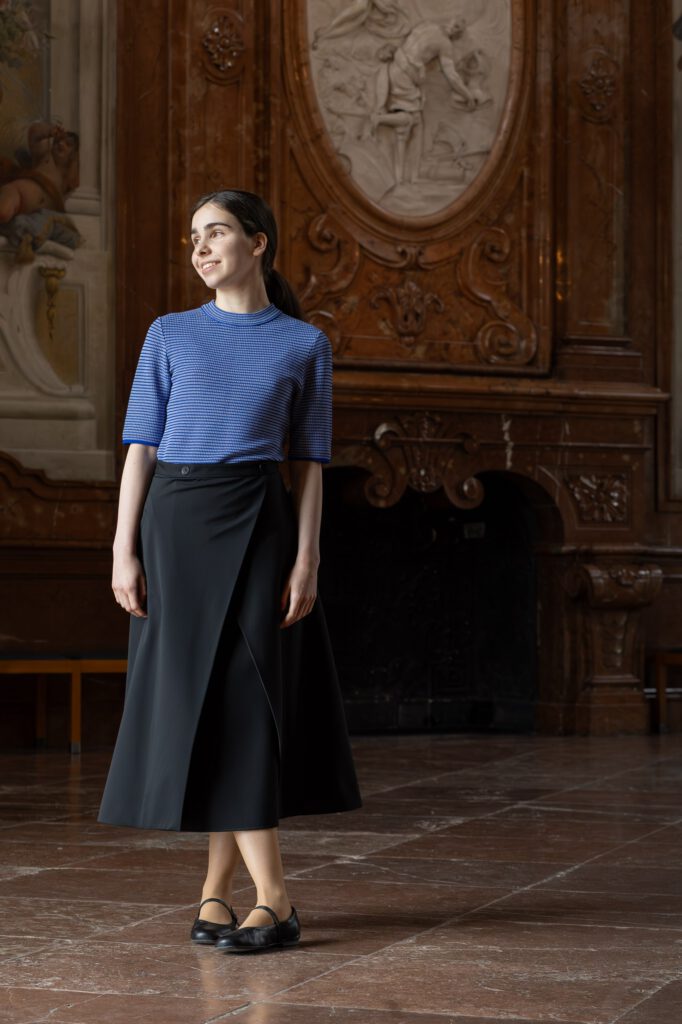
1 July 2024
Mariia Pylypenko: “The internship helped me develop clearer values, guiding my future path in the right direction”
Mariia Pylypenko, Professional Integration HUB 1.0 Program Participant (Belvedere Museum).
- Age: 21 years old
- City in Ukraine where you lived before the full-scale invasion (forced relocation): Kyiv
- Specialization: Art (Art Manager, Art Historian, Artist)
PROFESSIONAL BACKGROUND
Through my work at the M17 Contemporary Art Center in Kyiv, Ukraine, I have gained extensive experience in organizing and preparing both Ukrainian and international cultural and artistic projects. My responsibilities included creating visual and textual materials for project promotion, assisting in art collection management, and developing digital content, including website creation and maintenance for center-related projects. Additionally, I managed the center’s social media, developed content strategies, and prepared various content.
My professional background also includes volunteering as a museum tour guide at the Bohdan and Varvara Khanenko National Museum of Arts in Kyiv. There, I conducted personalized tours of the museum’s Western European collection and supported the coordination of various museum events through volunteer work.
The current state of the art field in Ukraine, particularly its art institutions, is characterized by significant uncertainty. On one hand, cultural institutions have faced notable obstacles due to the war, requiring efforts to preserve their collections while adapting to contemporary realities. On the other hand, the visibility of art institutions in society has significantly increased during these challenging times, as demonstrated by the growing public interest in their activities and the substantial support they receive from the international art community. Additionally, following the full-scale invasion, both art and other institutions have revealed their strengths and weaknesses. This has helped them develop strategies for their operations and continued growth, providing an opportunity to establish themselves within the European and international art context.

FORCED EMIGRATION
The war found me early in the morning in my flat in Kyiv. Despite the shock, I managed to maintain composure and a clear mind. Living in the basement car park of our building for several weeks, my family and I eventually decided to evacuate to Lviv, in Western Ukraine, to get a pregnant relative out of the city. Returning to Kyiv at the end of May 2022, I had no intention of leaving again. However, a month later, the situation took a sharp turn with alarming news of the russian aggression. One evening, my mother and I made a spontaneous decision to leave for a couple of weeks to wait out the war. The very next morning, we were on our way to Uzhhorod, in Western Ukraine, and from there, we traveled to Vienna – a city I had visited three times as a tourist before the full-scale invasion. Our stay in a hotel during those few weeks reflected the reality that emigration wasn’t on our minds; we were simply waiting for the war to end. However, despite our wishes, fate had its own plans that could not be avoided.
LIFE IN AUSTRIA
I am very grateful to Austria for welcoming Ukrainian refugees with open arms, offering help, and providing all kinds of assistance. I was deeply touched by the kindness of the locals, their sympathy, and their support. What impressed me then and continues to impress me today in Austria is witnessing the EU’s stated values in action – from the philosophy and people’s perception of life to environmental organization, urban planning, and climate justice. Additionally, the energy that people show in advocating for their rights and values, and their commitment to truth and justice, is truly remarkable.
The biggest challenge for me was not knowing German, which made many everyday processes very difficult, from writing emails to communicating on the street. However, many local people showed understanding, not judging foreigners for trying to speak German, making mistakes, and learning about Austrian culture.
The advice I can offer to Ukrainians abroad, and which I strive to follow myself, is to actively explore everything, step out of the bubble of one’s usual community, and try to integrate into the international or local context. This includes learning the language and exploring the cultural depths of others, no matter how difficult it may be.

PROFESSIONAL INTEGRATION HUB
I found out about the Professional Integration HUB program through an Instagram post and decided to take a chance and apply. The internship at the Austrian Gallery Belvedere successfully met its main expectations and goals. It provided an opportunity to immerse myself in the Austrian professional sphere, gaining insight into the various methods and aspects of the institution’s work. Moreover, it facilitated an understanding of the fundamental principles and structure of the Austrian art sector, along with the professional values of local art managers. This knowledge will be valuable for applying to the Ukrainian cultural sphere in the future.
Overall, the internship became an important stage in my life, offering me not only valuable experience working in a leading Austrian institution but also shaping my personal perception of the dynamics among individuals, society, and institutions in relation to artistic and cultural heritage. It helped me develop clearer values in this regard, guiding my future path in the right direction.
The main initiative I was involved in during my internship was the organization of the symposium “Storms and Networks: Modernisms in an Extended Territorial Context,” which took place within the exhibition “In the Eye of the Storm: Modernism in Ukraine” on May 7, 2024, at Belvedere 21. Firstly, I express my gratitude to Miroslav Haľák, the co-curator of the exhibition from Belvedere, for his support, assistance, and time. Secondly, I was thrilled to be part of this process, integrating myself into the institution’s extensive mechanism of work throughout my internship. The symposium, which brought together leading experts in the field of modernism in Central and Eastern Europe, served as a significant scientific event fostering the exchange of opinions on the development of early 20th-century art in these regions.
A comparison between the art scenes in Ukraine and Austria, focusing on art institutions, organizational processes, and employees’ individual attitudes towards their work, provides insight into the strengths and weaknesses of Ukraine’s professional sector. Existing within entirely different realities, living conditions, and societal roles often causes this gap. In times of crisis, individual employees in the Ukrainian art sector are crucial for managing challenges and keeping things running smoothly, often relying more on personal initiative than established procedures. It’s worth remembering the heroism of specialists, like the staff of the National Art Museum of Ukraine, who lived in the museum at the beginning of the war to save the collection. It is also important to note the developed ability of Ukrainian specialists to find solutions quickly in complex situations and organize workflow despite challenges, including lack of financial support and physical danger.

We can learn a lot from Austria. The main difference between Austrian and Ukrainian art institutions, in my opinion, lies in their emphasis on being process-oriented rather than just focusing on the result. In Austria, the emphasis is placed on the process of creating exhibitions or any other project, prioritizing the idea and message, as well as public discussion, over a written report of successful completion. This approach, along with the responsibility and involvement of everyone at every stage of work, is fundamental to the successful functioning of the institution.
Reflecting on the insights I’ve gained from the Austrian professional environment, I have been deeply impressed by the dedication of Austrian professionals towards their work. This passion not only inspires but also provides a crucial understanding of why the Austrian art sector functions so effectively: each individual not only acts professionally but also truly loves their work, fully immersing themselves in their subject in a way that leaves a lasting impression.
PLANS AFTER PARTICIPATING IN THE PROGRAM
The Professional Integration HUB program provided me with invaluable experiences and insights, from a clearer understanding of my professional development path to the incredible opportunity to work in a leading Austrian art institution. It also facilitated networking and gave me a solid grasp of the basic principles of the Austrian professional sphere, local values, and working practices. This opens the door to integration and offers the chance to apply this knowledge within the Ukrainian context.
Considering the important role of Ukrainian art during the war – as a platform for reflecting Ukrainian realities, sharing culture, and introducing the country to the global stage – incorporating European practices becomes essential for integrating Ukraine into the European context across various fields. For Ukrainian art institutions, which are consistently involved in societal discussions, adopting European standards could have a significant impact. This influence would extend to interactions with the local community, nurturing a new generation that prioritizes freedom, supporting art education and promotion, and bolstering the international presence and influence of Ukrainian institutions.